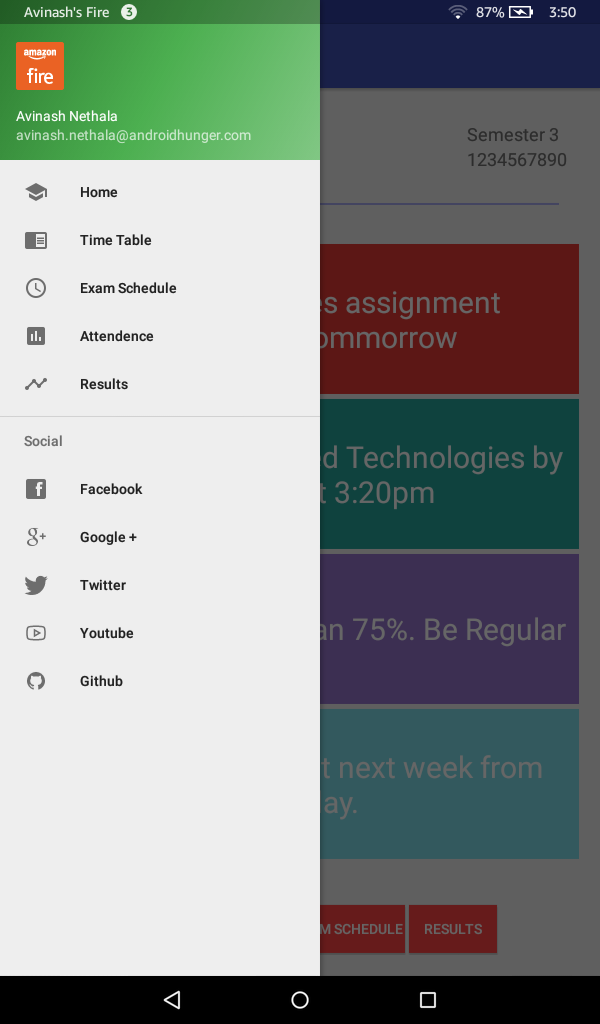
- #Android navigation drawer set icon how to#
- #Android navigation drawer set icon full#
- #Android navigation drawer set icon android#
- #Android navigation drawer set icon code#
The toolbar is wrapped inside the appbar. You can customize the navigationview header as you wish: Start by adding navigationview to your activity layout as follows
#Android navigation drawer set icon code#
As for the other layouts you’ll find them in the source code download. Let’s explore the navigationdrawer layoust. Your other layouts e.g fragments layouts, activity layouts etc.There are two types of layouts you need to create: You do this inside the menu folder in the resources directory: Implementation 'androidx.navigation:navigation-ui-ktx:2.0.0' Step 2: Create Menu Implementation 'androidx.navigation:navigation-fragment-ktx:2.0.0' Implementation 'androidx.lifecycle:lifecycle-extensions:2.0.0' Implementation 'androidx.navigation:navigation-ui:2.0.0' Implementation 'androidx.navigation:navigation-fragment:2.0.0' Implementation 'nstraintlayout:constraintlayout:1.1.3' However some androidx API’s will be used so add the following as dependencies: implementation ':material:1.1.0' We do no need any third party dependency.


#Android navigation drawer set icon how to#
With the first example you learn how to create a navigationdrawer/navigationview using Kotlin as the primary language.
#Android navigation drawer set icon android#
Now if you run your app, you should see the navigation drawer and be able to select between your fragments.Code Download Example 1: Kotlin Android NavigationView Example with Fragments In res/values-v19/styles.xml we can add the following: true It covers ~85% of Android devices worldwide as of 2019. Note many apps and developers switched to use minSdkVersion=21. Note: If you modify your res/values/styles.xml directly with this android:windowTranslucentStatus line, you are likely to need to build only for SDK versions 19 or higher, which will obviously limit you from supporting many older devices.

Because this style is not available for pre Kitkat devices, we'll add res/values-v19/styles.xml file for API version 19 and onwards. To have the status bar translucent and have our drawer slide over it, we need to set android:windowTranslucentStatus to true. One thing to note is that the ActionBarDrawerToggle renders a custom DrawerArrowDrawable for you for the hamburger icon.Īlso, make sure to be using version. The ActionBarToggle will perform the same function done previously but adds a bit more checks and allows mouse clicks on the icon to open and close the drawer. Make sure you have this Gradle dependency added to your app/adle file: dependencies The NavigationView should be backwards compatible with all versions down to Android 2.1. Make sure to setup the Google Design Support Library before using Google's new NavigationView, announced as part of the Android M release. Each item when clicked will switch the relevant fragment into the activity's container view. In this way, you can define multiple fragments, and then define the list of options which will display in the drawers items list. This guide explains how to setup a basic material design style drawer filled with navigation items that switch different fragments into the content area. Read the material design style navigation drawer document for specs on styling your navigation drawer.
#Android navigation drawer set icon full#
With the release of Android 5.0 Lollipop, the new material design style navigation drawer spans the full height of the screen and is displayed over the ActionBar and overlaps the translucent StatusBar. Released NavigationView, which makes it far easier to create it than the previously documented instructions.

One of the most flexible is the Navigation Drawer. In Common Navigation Paradigms cliffnotes, we discuss the various navigational structures available within Android apps.


 0 kommentar(er)
0 kommentar(er)
